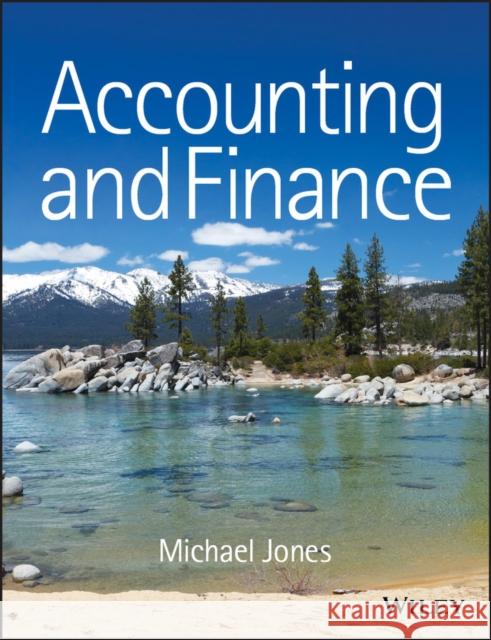Accounting and Finance for Non–specialists » książka



Accounting and Finance for Non–specialists
ISBN-13: 9781118932070 / Angielski / Miękka / 2014 / 688 str.
Accounting and Finance for Non–specialists
ISBN-13: 9781118932070 / Angielski / Miękka / 2014 / 688 str.
(netto: 270,83 VAT: 5%)
Najniższa cena z 30 dni: 284,37 zł
ok. 22 dni roboczych.
Darmowa dostawa!
An accessible introduction to the basics of financial accounting, management accounting and finance aimed at undergraduate and MBA students taking a first, non-specialist course in accounting and finance.
About the Author xv
About the Book xvii
Acknowledgements xxiii
1 INTRODUCTION TO ACCOUNTING AND FINANCE 1
Introduction 2
Nature of Accounting and Finance 2
Importance of Accounting and Finance 4
Financial Accounting and Management Accounting 5
Users of Accounts 7
Accounting Context 9
Types of Accountancy 12
Types of Accountant 18
Limitations of Accounting 21
Conclusion 21
Discussion Questions 23
SECTION A: FINANCIAL ACCOUNTING: THE TECHNIQUES 25
2 THE ACCOUNTING BACKGROUND 27
Introduction 28
Financial Accounting 28
Language of Accounting 30
The Process of Accounting 38
The Accounting Equation 38
Student Example 44
Why Is Financial Accounting Important? 48
Accounting Principles 48
Accounting Conventions 49
Conclusion 51
Discussion Questions 52
Numerical Questions 53
Appendix 2.1: Illustration of a Consolidated Income Statement for Marks & Spencer plc 2010 55
Appendix 2.2: Illustration of a Consolidated Statement of Financial Position for Marks and Spencer plc 2010 57
Appendix 2.3: Illustration of a Consolidated Statement of Cash Flows for Marks and Spencer 2010 59
Appendix 2.4: Illustration of a Consolidated Income Statement for Volkswagen 2009 61
Appendix 2.5: Illustration of a Consolidated Balance Sheet (Statement of Financial Position) for Volkswagen 2009 62
Appendix 2.6: Illustration of a Consolidated Cash Flow Statement (Statement of Cash Flows) for Volkswagen 2009 64
3 MAIN FINANCIAL STATEMENTS: THE INCOME STATEMENT (PROFIT AND LOSS ACCOUNT) 66
Introduction 67
Context 67
Definitions 69
Layout 71
Main Components 72
Profit 80
Listed Companies 83
Capital and Revenue Expenditure 83
Limitations 84
Interpretation 84
Conclusion 84
Discussion Questions 85
Numerical Questions 85
4 MAIN FINANCIAL STATEMENTS: THE STATEMENT OF FINANCIAL POSITION (BALANCE SHEET) 87
Introduction 88
Context 89
Definitions 90
Layout 91
Main Components 93
Limitations 104
Interpretation 105
Listed Companies 106
Conclusion 106
Discussion Questions 107
Numerical Questions 108
Appendix 4.1: Horizontal Format of Statement of Financial Position 109
5 PREPARING THE FINANCIAL STATEMENTS 110
Introduction 111
Main Financial Statements 111
Trial Balance to the Income Statement (Profi t and Loss Account) and the Statement of Financial Position (Balance Sheet) 113
Adjustments to Trial Balance 117
Comprehensive Example 125
Conclusion 129
Discussion Questions 129
Numerical Questions 130
6 PARTNERSHIPS AND LIMITED COMPANIES 142
Introduction 143
Context 144
Partnerships 145
Limited Companies 151
Distinctive Accounting Features of Limited Companies 155
Accounting Treatment For Limited Companies 164
Limited Company Example: Stevens, Turner Ltd 166
Limited Companies: Published Accounts 171
Conclusion 176
Discussion Questions 177
Numerical Questions 178
Appendix 6.1: Example of an Income Statement (Profi t and Loss Account) using UK GAAP (Manchester United Ltd) 188
Appendix 6.2: Example of a Statement of Financial Position (Balance Sheet) using UK GAAP (Manchester United Ltd) 189
7 MAIN FINANCIAL STATEMENT: THE STATEMENT OF CASH FLOWS 191
Introduction 192
Importance of Cash 193
Context 195
Cash and the Bank Account 195
Relationship between Cash and Profi t 199
Preparation of Statement of Cash Flows 201
Conclusion 215
Discussion Questions 215
Numerical Questions 216
Appendix 7.1: Main Headings for the Cash Flow Statement (Statement of Cash Flows) for Sole Traders, Partnerships and some Non–Listed Companies under UK GAAP 223
Appendix 7.2: Preparation of a Sole Trader s Cash Flow Statement Using the Direct Method Using UK Format 224
Appendix 7.3: Preparation of the Cash Flow Statement of Any Company Ltd using the Indirect Method Using UK GAAP 225
Appendix 7.4: Example of Statement of Cash Flow (Cash Flow Statement) Using UK GAAP (Manchester United Ltd) 228
8 INTERPRETATION OF ACCOUNTS 230
Introduction 231
Context 231
Overview 232
Importance of Ratios 234
Closer Look at Main Ratios 235
Worked Example 247
Report Format 255
Holistic View of Ratios 257
Performance Indicators 258
Limitations 259
Conclusion 260
Discussion Questions 261
Numerical Questions 262
Appendix 8.1: John Brown Plc 271
Appendix 8.2: The Cash Flows Ratio using UK GAAP 273
SECTION B: FINANCIAL ACCOUNTING: THE CONTEXT 275
9 REGULATORY AND CONCEPTUAL FRAMEWORKS 277
Introduction 278
Traditional Corporate Model: Directors, Auditors and Shareholders 279
Regulatory Framework 284
Regulatory Framework in the UK 290
Corporate Governance 295
Conceptual Framework 300
Conclusion 308
Selected Reading 309
Discussion Questions 310
10 MEASUREMENT SYSTEMS 311
Introduction 312
Overview 312
Measurement Systems 315
Deficiencies of Historical Cost Accounting 317
Illustrative Example of Different Measurement Systems 317
Real Life 320
Conclusion 321
Selected Reading 321
Discussion Questions 322
11 THE ANNUAL REPORT 323
Introduction 324
Definition 324
Context 325
Multiple Roles 326
Main Contents of the Annual Report 331
Presentation 348
Group Accounts 350
Impression Management 354
Conclusion 357
Selected Reading 358
Discussion Questions 359
SECTION C: MANAGEMENT ACCOUNTING 361
12 INTRODUCTION TO MANAGEMENT ACCOUNTING AND FINANCE 363
Introduction 364
Context 365
Relationship with Financial Accounting 366
Relationship between Management Accounting and Finance 368
Overview 368
Cost Minimisation and Revenue Maximisation 376
Use of Computers and Impact of Digital Technology 377
Art not a Science 378
Changing Nature of Management Accounting 379
Conclusion 379
Selected Reading 380
Discussion Questions 381
13 COSTING 382
Introduction 383
Importance of Cost Accounting 384
Types of Cost 385
Traditional Costing 389
Activity–Based Costing 395
Costing for Inventory Valuation 399
Different Costing Methods for Different Industries 403
Target Costing 407
Cost–Cutting 407
Conclusion 408
Discussion Questions 409
Numerical Questions 409
14 PLANNING, CONTROL AND PERFORMANCE: BUDGETING 415
Introduction 416
Management Accounting Control Systems 416
Nature of Budgeting 417
Cash Budget 421
Other Budgets 422
Manufacturing Budgets 425
Comprehensive Budgeting Example 428
Behavioural Aspects of Budgeting 433
Responsibility Accounting 437
Conclusion 439
Discussion Questions 439
Numerical Questions 440
15 PLANNING, CONTROL AND PERFORMANCE: STANDARD COSTING 445
Introduction 446
Nature of Standard Costing 447
Standard Cost Variances 448
Interpretation of Variances 457
Conclusion 458
Discussion Questions 459
Numerical Questions 460
16 SHORT–TERM DECISION MAKING 464
Introduction 465
Decision Making 465
Contribution Analysis 467
Decisions, Decisions 471
Throughput Accounting 477
Break–Even Analysis 479
Contribution Graph 483
Conclusion 485
Discussion Questions 486
Numerical Questions 486
SECTION D: BUSINESS FINANCE 491
17 LONG–TERM DECISION MAKING: CAPITAL INVESTMENT APPRAISAL 493
Introduction 494
Nature of Capital Investment 494
Capital Investment Appraisal Techniques 498
Payback Period 500
Accounting Rate of Return 502
Net Present Value 504
Profitability Index 507
Internal Rate of Return (IRR) 507
Other Factors 512
Conclusion 512
Discussion Questions 513
Numerical Questions 514
Appendix 17.1: Present Value of £1 at Compound
Interest Rate (1 + r) 517
18 THE SOURCES OF FINANCE 518
Introduction 519
Nature of Sources of Finance 519
Long–Term Financing 520
Cost of Capital 531
Conclusion 534
Discussion Questions 535
Numerical Questions 536
19 MANAGEMENT OF WORKING CAPITAL 537
Introduction 538
Working Capital 538
Short–Term Financing 541
Conclusion 552
Discussion Questions 552
Numerical Questions 553
Glossary of Key Accounting Terms 555
Appendix: Answers 587
Index 641
Michael Jones is Professor of Financial Reporting and Director of the Financial Reporting and Business Communication Unit at the University of Bristol. He is also author of Accounting 3rd Edition, Financial Accounting 2nd Edition, Creative Accounting, Fraud and International Accounting Scandals and Management Accounting, all published by John Wiley and Sons Ltd.
Accounting and finance are key aspects of business. All those who work for, or deal with, businesses need to understand these subjects. Essentially, understanding accounting and finance is a prerequisite for understanding business.
Accounting and Finance is intended as an essential textbook for students studying accounting and finance for the first time and aims to equip them with the necessary understanding of the theory and practice of financial accounting, management accounting and business finance. The text provides a self–contained, introductory, one–year course covering all the major aspects of accounting and finance, which can be used by students on both accounting and non–accounting degrees, as well as those on MBA and MSC courses. It is designed to be useful for UK students and for those studying accounting in English overseas
Designed to be engaging and accessible, Accounting and Finance features:
- Lively and clear presentational style
- Full IFRS coverage
- Combination of theory and practice stressing the underlying concepts and the context within which accounting operates
- Comprehensive chapter on the interpretation of accounts
- Financial data from a wide variety of international companies
- Numerous real–life examples to bring the subject to live
- End–of–chapter question of escalating difficulty together with accompanying answers, enabling the student to develop their understanding of the key concepts
- Rich supporting website at www.wileyeurope.com/college/jones featuring accounting concept modules for students as well as solutions, quizzes, extra questions and PowerPoint slides for lecturers.
1997-2025 DolnySlask.com Agencja Internetowa
KrainaKsiazek.PL - Księgarnia Internetowa









